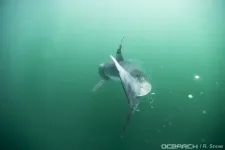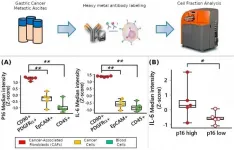(Press-News.org) Uncovering detailed travel patterns and habitat use of sharks along and across shelf territories has been historically challenging - especially for most pelagic shark species - which remain offshore for most of their lives. Their vertical diving behavior has been a subject of inquiry for a long time, and for young sharks in particular, has remained elusive.
Using cutting-edge 3D satellite technology, a study led by Florida Atlantic University's Harbor Branch Oceanographic Institute, in collaboration with NOAA's National Marine Fisheries Service; OCEARCH; The South Fork Natural History Museum and Nature Center; and the Wildlife Conservation Society, is providing a unique look into how young white sharks in the North Atlantic Ocean travel and use their habitats. The study also is the first to provide fine-scale analysis of vertical movement behavior in young-of-year (1 to 2 years) and juvenile white sharks (Carcharodon carcharias) in the New York Bight, the only confirmed white shark nursery area in the entire North Atlantic Ocean.
Results published in the journal Frontiers in Marine Science, showed that across multiple years, the tagged young white sharks consistently displayed horizontal movements parallel to Long Island's southern shoreline and the New Jersey coast and likely cling to these waters due to their summertime productivity. Horizontal movements ranged from the surf zone to more than 130 kilometers from shore; however, more than 90 percent of the sharks were positioned within 20 kilometers of Long Island's southern shoreline, which further confirms the importance of this region to baby white sharks.
Data from the study simultaneously address many questions on the ecology, behavior and conservation of a highly mobile marine species that has been challenging to explore, and will inform ongoing preservation strategies for this vulnerable white shark population.
"We have known about the importance of nurseries for young sharks for some time, however, knowledge of the finer scale use of shelf systems by these animals has been limited. This lack of information impacts our understanding of potential shark 'hotspots' within these large ecosystems," said Rachel Shaw, lead author, and a recent graduate from the Fisheries Ecology and Conservation (FEC) Lab, led by Matt Ajemian, Ph.D., co-author and an assistant research professor at FAU Harbor Branch.
Between 2016 and 2019, 21 young-of-year and juvenile white sharks were fitted with satellite and acoustic tags to examine their distribution and habitat selection during late summertime (August to October) in the New York Bight - the coastal region between Montauk, New York and Cape May, New Jersey. Movement data from the 21 young white sharks were collected (11 males and 10 females ranging in size from 54 to 61 inches in length) and linked to environmental measurements from remote sensing platforms.
These data sets produced the first-ever glimpse into the 3D movements for these young white sharks alongside oceanographic features like bathymetry (submarine topography), sea surface temperature, chlorophyll-a levels, and sea surface salinity.
"Undoubtedly, our research shows that young white sharks traverse variable oceanographic features across the continental shelf in the New York Bight, but they certainly have their habitat preferences," said Shaw.
The vertical diving behavior and accompanying measurements showed that sharks encountered several areas across the shelf with thermally stratified water column structure. This was most evident around the Hudson Shelf Valley region where some of the coldest bottom temperatures were recorded during the summertime, and is indicative of the "cold pool" that sets up in this region. Further, young white sharks also selected areas with relatively high levels of productivity (i.e., mesotrophic waters) as reflected by salinity and chlorophyll-a concentration. Tagged individuals selected sea surface salinities slightly less saline than oceanic waters, which are typically associated with coastal areas.
Altogether, the research suggests young white sharks prefer nearshore habitats, but can exhibit connectivity between the immediate shoreline and mid-continental shelf region, where they play important ecological roles as apex predators on a variety of species. The study improves characterization of essential habitat for young white sharks and provides new insights into their reliance on this productive continental shelf ecosystem, which may provide them with the resources needed to grow quickly as well as a refuge from predators.
"While the northwest Atlantic white shark population appears to be recovering from historical overfishing, there is considerable uncertainty in their population dynamics, seasonal habitat preferences, ecological roles, and exposure to environmental impacts," said Ajemian. "Understanding species-habitat relationships is critical for predicting the potential impacts of long-term environmental changes including climate change, which is disproportionately affecting this region."
INFORMATION:
Study co-authors are Tobey H. Curtis, Ph.D., NOAA National Marine Fisheries Service, Atlantic Highly Migratory Species Management Division; Gregory Metzger, The South Fork Natural History Museum and Nature Center; Michael P. McCallister, MSc, FEC Laboratory, FAU Harbor Branch; Alisa Newton, Ph.D., Wildlife Conservation Society; and G. Christopher Fischer, OCEARCH.
Funding and support was provided by OCEARCH; Harbor Branch Oceanographic Institute Foundation; Florida Atlantic University Foundation; The South Fork Natural History Museum and Nature Center; Andrew F. Sabin Family Foundation; NOAA National Marine Fisheries Service, Atlantic Highly Migratory Species Management Division; Southampton Public Schools; Lotek Wireless; and a number of private donors.
- FAU -
About Harbor Branch Oceanographic Institute:
Founded in 1971, Harbor Branch Oceanographic Institute at Florida Atlantic University is a research community of marine scientists, engineers, educators and other professionals focused on Ocean Science for a Better World. The institute drives innovation in ocean engineering, at-sea operations, drug discovery and biotechnology from the oceans, coastal ecology and conservation, marine mammal research and conservation, aquaculture, ocean observing systems and marine education. For more information, visit http://www.fau.edu/hboi.
About Florida Atlantic University:
Florida Atlantic University, established in 1961, officially opened its doors in 1964 as the fifth public university in Florida. Today, the University serves more than 30,000 undergraduate and graduate students across six campuses located along the southeast Florida coast. In recent years, the University has doubled its research expenditures and outpaced its peers in student achievement rates. Through the coexistence of access and excellence, FAU embodies an innovative model where traditional achievement gaps vanish. FAU is designated a Hispanic-serving institution, ranked as a top public university by U.S. News & World Report and a High Research Activity institution by the Carnegie Foundation for the Advancement of Teaching. For more information, visit http://www.fau.edu.
Of the many perplexing questions surrounding SARS CoV-2, a mysterious new pathogen that has killed an estimated 2.6 million people worldwide, perhaps the most insistent is this: why does the illness seem to strike in such a haphazard way, sometimes sparing the 100 year old grandmother, while killing healthy young men and women in the prime of life?
A new study by Karen Anderson, Abhishek Singharoy and their colleagues at the Biodesign Institute at Arizona State University, may offer some tentative clues. Their research explores MHC-I, a critical protein component of the human adaptive immune system.
The research suggests that certain variant ...
A NIMS research team devised a new thermoelectric generation mechanism with a hybrid structure composed of thermoelectric and magnetic materials. The team then actually fabricated this structure and observed the record-high thermopower appearing in the direction perpendicular to a temperature gradient (i.e., transverse thermoelectric generation). These results may offer insights into new mechanisms and structural designs applicable to the development of versatile energy harvesting technologies and highly sensitive heat flux sensors.
The Seebeck effect is a phenomenon in which a temperature gradient across a metal or semiconductor is converted into a thermoelectric voltage. Because this effect can be used to convert waste heat into electrical energy, its potential applications (e.g., ...
Through an analysis of cellular components (cell fractions) from malignant ascites (fluid buildup in the abdomen caused by gastric cancer), a research collaboration based in Kumamoto University (Japan) has demonstrated that cellular senescence of cancer-associated fibroblasts (CAFs) play an important role in the peritoneal dissemination of gastric cancer foci (cells different from surrounding cells). This understanding should enable the development of new treatments for cancer dissemination in the peritoneum by targeting cancer cells at focal sites and CAFs in patients with gastric cancer.
Peritoneal dissemination ...
Plant species with short generation times are more sensitive to climate change than those with long generation times. This is one of the findings of a synthesis study by researchers from the German Centre for Integrative Biodiversity Research (iDiv), the Martin Luther University Halle-Wittenberg (MLU) and the Helmholtz-Centre for Environmental Research (UFZ). The international team comprehensively compiled worldwide available data, mostly from Europe and North America, to address the question of how plant populations react to climate change. The study, published in Nature Communications, shows that plant characteristics such as generation ...
Consumption of ultra-processed foods and drink could increase the risk of developing colorectal cancer. This was the conclusion of a large study undertaken by the Barcelona Institute for Global Health (ISGlobal), a centre supported by the "la Caixa" Foundation, based on questionnaires about food behaviours completed by around 8,000 people in Spain. The study, the first of its kind in the country, also analysed the relationship between ultra-processed food and drink products and two other cancers; while no association was observed with prostate cancer, in the case of breast cancer a higher risk was observed in the sub-group of former and current smokers who reported a ...
More extroverted people suffered mood declines while more introverted people saw mood improvements during the early COVID-19 pandemic, in survey of students at a U.S. university.
INFORMATION:
Publicly available article: https://journals.plos.org/plosone/article?id=10.1371/journal.pone.0248895
Article Title: "Personality trait predictors of adjustment during the COVID pandemic among college students"
Funding: This work was supported by a grant to Dr. Jim Hudziak from the Conrad Hilton Foundation (https://www.hiltonfoundation.org/). The funders had no role in study design, data collection and analysis, decision ...
The question of the origin of the language is one of the most important and at the same time one of the most difficult to solve. It was formulated in antiquity and has inspired religion and philosophy ever since, in some periods, above all the Enlightenment, becoming the axis of reflection on other fundamental issues, such as human nature. In the last few decades, research in this field has intensified, drawing on evolutionism and having an interdisciplinary character, involving linguists, psychologists, primatologists and neuroscientists. The study of language evolution is currently considered one of the most ...
The Covid-19 Crisis is deepening the divide between energy transition frontrunners and laggards. In a new publication, researchers from the Institute for Advanced Sustainability Studies (IASS) in Potsdam present an overview of the global impact of the coronavirus pandemic on the energy sector. Their findings show that low- and middle-income countries need more support in their efforts to ditch fossil fuels.
The crisis will heighten existing imbalances in an uneven energy transition landscape. Despite the crisis, frontrunners in the global energy transition will continue to expand their renewable energy capacities, while laggards will fall further behind. In Europe, the Green Deal ...
A new study of mortality among young adults born prematurely includes 6.3 million adults under the age of 50 in Norway, Sweden, Finland and Denmark. Among this group, 5.4 per cent were born before term, according to Professor Kari Risnes at the Norwegian University of Science and Technology's (NTNU) Department of Clinical and Molecular Medicine and St. Olavs Hospital.
Researchers used national birth registers and compared them with the cause of death registers that all Scandinavian countries have.
"We already know that preemies have increased mortality in childhood and early adulthood. Now we've confirmed the risk of death from chronic diseases such as heart disease, ...
An international group of researchers led by the University of Adelaide has conducted a comprehensive genetic analysis and found no evidence of interbreeding between modern humans and the ancient humans known from fossil records in Island Southeast Asia. They did find further DNA evidence of our mysterious ancient cousins, the Denisovans, which could mean there are major discoveries to come in the region.
In the study published in Nature Ecology and Evolution, the researchers examined the genomes of more than 400 modern humans to investigate the interbreeding events between ancient humans and modern ...






